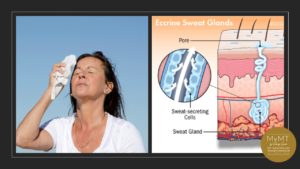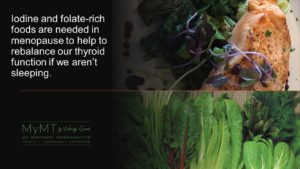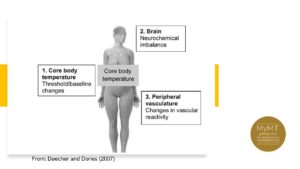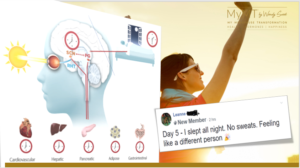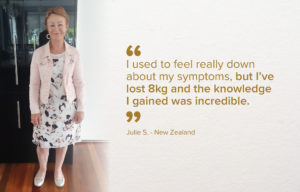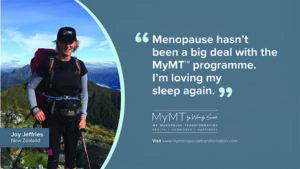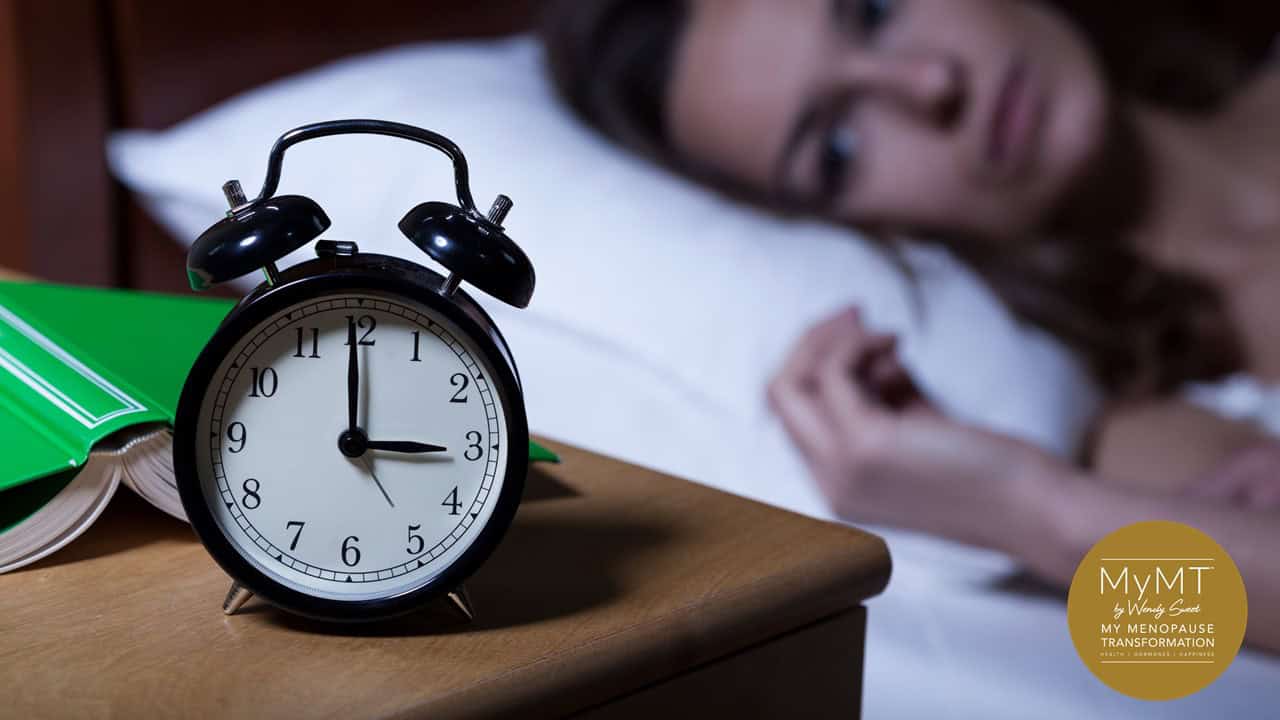“I’m lying awake every night and dripping with sweat!” This was the cry I received last week from a lady living in the United Kingdom. Despite being on HRT she was confused. At only 46 years old, she also didn’t understand why her night sweats were even happening. At first she blamed the heat-wave, but night after night of waking up was leaving her exhausted. All this at a time when she needed to be on her game with working from home with her job changes which arrived during lockdown.
If this is you as well, then have a read when you get time because you need to understand that both our sweat glands and our skin respond to oestrogen. When oestrogen is lowering as we go into and through menopause (and into post-menopause), then our body can’t get rid of internal heat as readily as it used to.
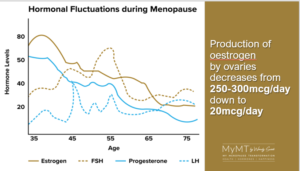
As I often say to women who come onto the MyMT™ online programmes, hot flushes are a sign that your internal or ‘core’ temperature is higher than it should be. We all know that sweating is a natural survival mechanism, but why and how does it become so disrupted as we move into mid-life?
Sweating is your survival mechanism to help your body cope with heat that is building up internally, such as when we have a fever or we have inflammation inside us, or we are exercising in hot environments. But we also sweat and experience hot flushes when we reach peri-menopause (the start of our reproductive ageing, when oestrogen and progesterone production decline).
The question is why …
Night sweats during your menopause transition are caused by lowering oestrogen having an effect on other areas in the body which regulate your temperature. Sometimes this temperature regulation gets out of balance if we are exercising in hot environments, or living and working in hot environments but what about during menopause? This was my curiosity too.
Our temperature is usually a well-balanced mechanism that is directed by our pituitary gland in our brain. Normally and ideally, there is good balance between our pituitary hormones, thryoid hormones and our adrenal (stress) hormones. However, these can quickly get out of balance when:
1. Our body is moving towards menopause and the ‘master’ pituitary hormones in the brain that regulate oestorgen and progesterone are changing.
2. When we aren’t sleeping.
3. When we are accumulating inflammation in our joints, muscles, gut and liver as we age.
4. When our diet doesn’t give us the nutrients we need to reduce inflammatory changes in the body. This includes magnesium, potassium, iron, Vitamin D, B12 and iodine. All of these nutrients help to regulate our blood pressure, heart rate and temperature too.
For example, if our diet doesn’t match the changes that arrive in our menopause transition (e.g. if we are low in iron, iodine, magnesium or folate), or if we have inflammation that has been building up in our joints and muscles as our joints lose the role of oestrogen, or if we are doing lots of vigorous exercise too often and not sleeping well, then all these factors might also impact on the regulation of our body’s heat production causing our temperature to go into over-drive.
When our temperature builds up inside us, othere changes go on to try to keep the heat under control. In other words, our body tries to adjust and ‘right’ itself and the hormones that come into play to do this are our thyroid and adrenal hormones. Sweating is your body trying to get of excess heat. As many of you already know, if it’s happenning at night, then you wake up with the sheets of your bed soaked. Night after night. The only thing that changes is your laundry pile.
When I was really trying to understand why I was experiencing night sweats and lots of hot flushes, I was guided by the great work of Deecher and Dories (2007)*. Their studies explain that when we have night sweats, there is a problem with the neural (nerve) and hormonal ‘communication’ between three areas. These are:
1. The pituitary gland in the brain.
2. Our thyroid gland (which requires iodine and selenium to regulate it).
3. Our skin – which we often forget is the largest organ in the body containing millions of tiny blood vessels that go to our sweat glands. The function of sweat glands are affected by low oestrogen too. They don’t dilate as much.
This means that to sort out your night sweats, you need to focus on these three key areas, not just the changing levels of oestrogen and progesterone, which has been the hallmark of menopause treatment for decades.
When we focus on these three areas, then we can usually un-pack why we are getting night sweats, when we never used to.
One of the first things to understand is that our core body temperature is regulated by our brain (pituitary gland) and it works to our 24 hour circadian rhythm. This is why if you are frustrated and weary from your night sweats and lack of sleep, then the management of this begins by turning around your circadian rhythm (I have the step-by-step plan for this in the SLEEP ALL NIGHT module in both the MyMT™
programmes .
But when we overheat and sweat at night, something is up with the nervous system and our temperature regulation too.
The normal response to over-heating is that when core body temperature goes high, this is communicated to the brain by hot and cold temperature receptors around the body. They are located in your skin (the largest organ), your gut, your thyroid, your blood vessels and your spinal cord. Therefore, messages about your temperature regulation occur at many different sites in your body. If ou already have GUT HEALTH concerns, then it’s important to sort this out as well.
During Menopause Our Blood Vessels are Changing Too:
Normally, when our core body temperature goes higher than it should, then peripheral vaso-dilation (dilation of our blood vessels) is triggered, resulting in increased blood flow to the blood vessels in our skin where our sweat glands are located. This sequence of events is regulated by our thyroid and our nervous system, which controls blood pressure and blood vessel dilation.
But here’s the kicker, – these sites are also where you have oestrogen receptors too. Hence, during menopause, these oestrogen receptors cannot do their job properly.
How do we manage this temperature chaos during menopause?
I want you to think about the night sweats in terms of the three areas – pituitary, thyroid and skin. All are controlled by our circadian rhythm, the way we adapt to our environment, our stress levels and the nutrients that control our thyroid health – iodine and selenium. Get these areas sorted first – (which is what women learn on the MyMT™ programmes).
For those of you in the Northern Hemisphere already in summer, you need to get outside and let your skin breathe – it’s your largest organ. So wear loose clothing, go barefoot if possible and cool your hands down by running cold water over the wrist and palms. Same with your feet. The feet and hands have numerous blood vessels which help to dissipate or reduce heat. They are an important component of our evolutionary cooling mechanism. When our feet are cool, we feel cooler inside our body.
I have other strategies that I have researched in my programmes, and this also includes lists of foods which help to keep us cool. We also need to eat lightly at night too and the timing of foods is critical to turning off night sweats. When we eat lightly at night, the gut (which has all the temperature sensors too), doesn’t have to process and digest larger meals that we are generally used to in the evening. This is particularly important for some proteins, which increase metabolism and are known as being ‘thermo-genic’ or heat generating.
A word of caution though – the official term for night sweats is ‘hyper-hidrosis’ and it is well known in medicine, that an under-lying virus can also disrupt temperature regulation. In light of the current pandemic, then if you aren’t getting on top of your night sweats and/or you aren’t at the right age for your menopause transition, then please see your Doctor.
If you are having problems getting on top of your sleep, especially those of you in the Northern Hemisphere who are experiencing heat waves, then I would love you to have a look at my 12 week menopause symptom reduction programmes. These are currently on sale for you as I know many of you may not be coping well with the pandemic, let alone menopause symptoms.
There are videos on these pages for you to listen to about what you receive and how you can access them on-demand, in your own time. The promo code to access NZ$50 (approx. UK£24/ US$30) off is JOIN MYMT – enter this into the promo-code area in any Buy Now button. Women call the programmes ‘life-changing’. I hope you do as well.
Dr Wendy Sweet, PhD & Member: Australasian Society of Lifestyle Medicine/ Women’s Healthy Ageing Researcher & MyMT™ Founder].
* [Deecher, D. & Dorries, K. (2007). Understanding the pathophysiology of vasomotor symptoms (hot flushes and night sweats) that occur in peri-menopause, menopause and post-menopause life stages. Archives of Women’s Mental Health, 10: 247-257]
24

